check engine Oldsmobile Achieva 1998 s Owner's Guide
[x] Cancel search | Manufacturer: OLDSMOBILE, Model Year: 1998, Model line: Achieva, Model: Oldsmobile Achieva 1998Pages: 356, PDF Size: 18.04 MB
Page 251 of 356
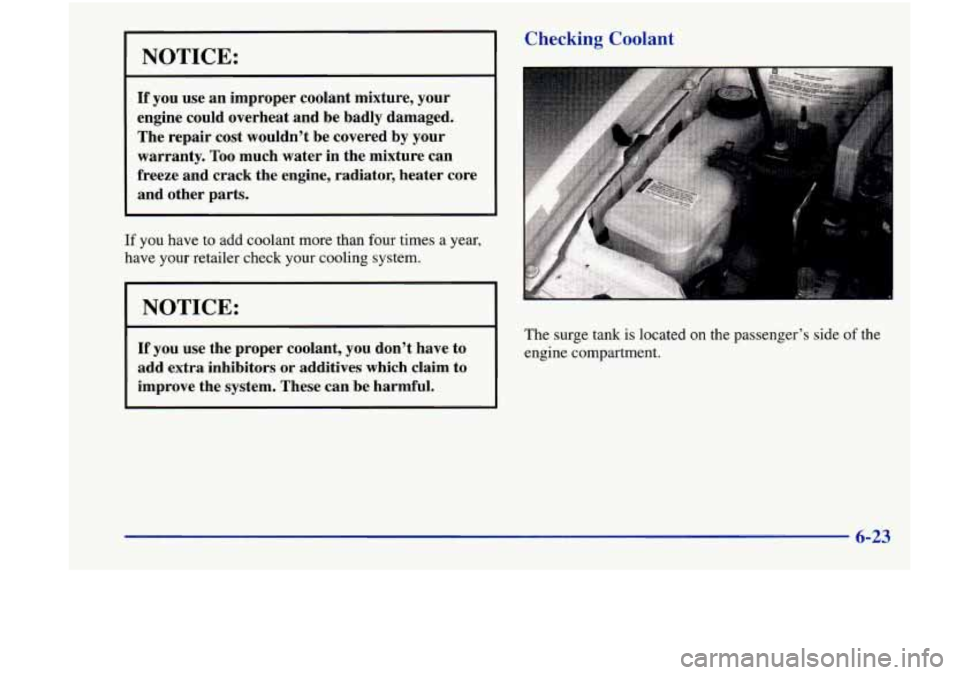
NOTICE:
If you use an improper coolant mixture, your
engine could overheat and be badly damaged.
The repair cost wouldn’t be covered by your
warranty. Too much water in the mixture can
freeze and crack the engine, radiator, heater core
and other parts.
If you have to add coolant more than four times a year,
have your retailer check your cooling system.
I NOTICE: I
If you use the proper coolant, you don’t have to
add extra inhibitors or additives which claim to
improve the system. These can be harmful.
Checking Coolant
The surge tank is located on the passenger’s side of the
engine compartment.
6-23
Page 253 of 356
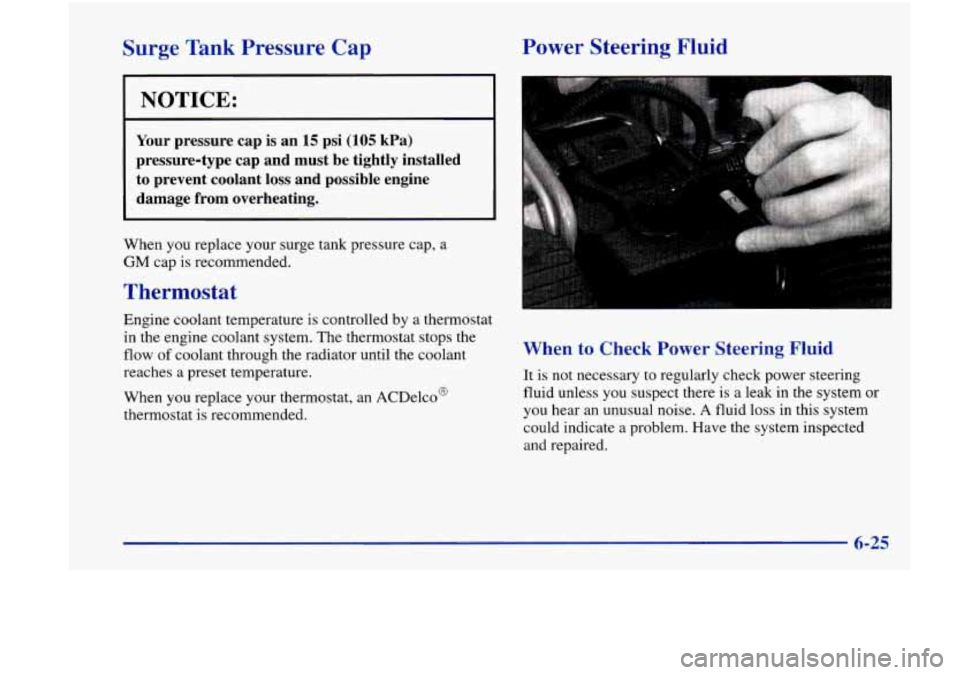
Surge Tank Pressure Cap Power Steering Fluid
I NOTICE:
Your
pressure cap is an 15 psi (105 kPa)
pressure-type cap and must
be tightly installed
to prevent coolant loss and possible engine
damage from overheating.
When you replace your surge tank pressure cap, a
GM cap is recommended.
Thermostat
Engine coolant temperature is controlled by a thermostat
in the engine coolant system. The thermostat stops the
flow
of coolant through the radiator until the coolant
reaches a preset temperature.
When you replace your thermostat, an ACDelco@
thermostat is recommended. When to Check Power Steering Fluid
It is not necessary to regularly check power steering
fluid unless you suspect there
is a leak in the system or
you hear an unusual noise. A fluid loss in this system
could indicate
a problem. Have the system inspected
and repaired.
Page 254 of 356
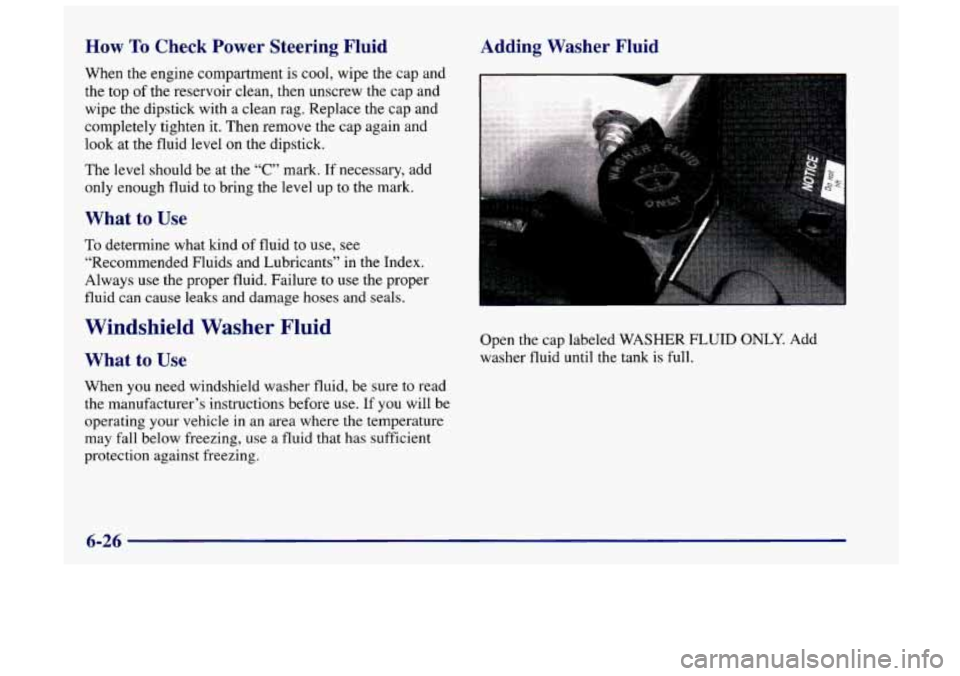
How To Check Power Steering Fluid
When the engine compartment is cool, wipe the cap and
the top
of the reservoir clean, then unscrew the cap and
wipe the dipstick with a clean rag. Replace the cap and
completely tighten it. Then remove the cap again and
look at the fluid level
on the dipstick.
The level should be at the
“C” mark. If necessary, add
only enough fluid to bring the level up to the mark.
What to Use
To determine what kind of fluid to use, see
“Recommended
Fluids and Lubricants” in the Index.
Always use the proper fluid. Failure to use the proper
fluid can cause leaks and damage hoses and seals.
Windshield Washer Fluid
What to Use
When you need windshield washer fluid, be sure to read
the manufacturer’s instructions before use.
If you will be
operating your vehicle in an area where the temperature
may fall below freezing, use a fluid that has sufficient
protection against freezing.
Adding Washer Fluid
Open the cap labeled WASHER FLUID ONLY. Add
washer fluid until the tank
is full.
6-26
Page 280 of 356

Vehicle Identification Number (VIN)
ENGINE/ 1998 T ASSEMBLY
CODE MODEL YEAR PLANT
This is the legal identifier for your vehicle. It appears
on a plate in the front corner of the instrument panel, on
the driver’s side. You can see it if you look through the
windshield from outside your vehicle. The
VIN also
appears on the Vehicle Certification and Service Parts
labels and
the certificates of title and registration.
Engine Identification
The 8th character in your VIN is the engine code. This
code will help you identify your engine, specifications
and replacement parts.
Service Parts Identification Label
You’ll find this label on the bottom of your spare tire
cover. It’s very helpful
if you ever need to order parts.
On this label is:
your VIN,
0 the model designation,
0 paint information and
a list of all production options and
Be sure that this label is not removed from the vehicle.
special equipment.
Electrical System
Add-on
Electrical Equipment
I NOTICE:
Don’t add anything electrical to your vehicle
unless you check with your retailer first. Some
electrical equipment can damage your vehicle
and the damage wouldn’t be covered by your
warranty. Some add-on electrical equipment
can keep other components from working as
they should.
Your vehicle has an air bag system. Before attempting to
add anything electrical
to your vehicle, see “Servicing
Your Air Bag-Equipped Vehicle” in the Index.
6-52
Page 281 of 356
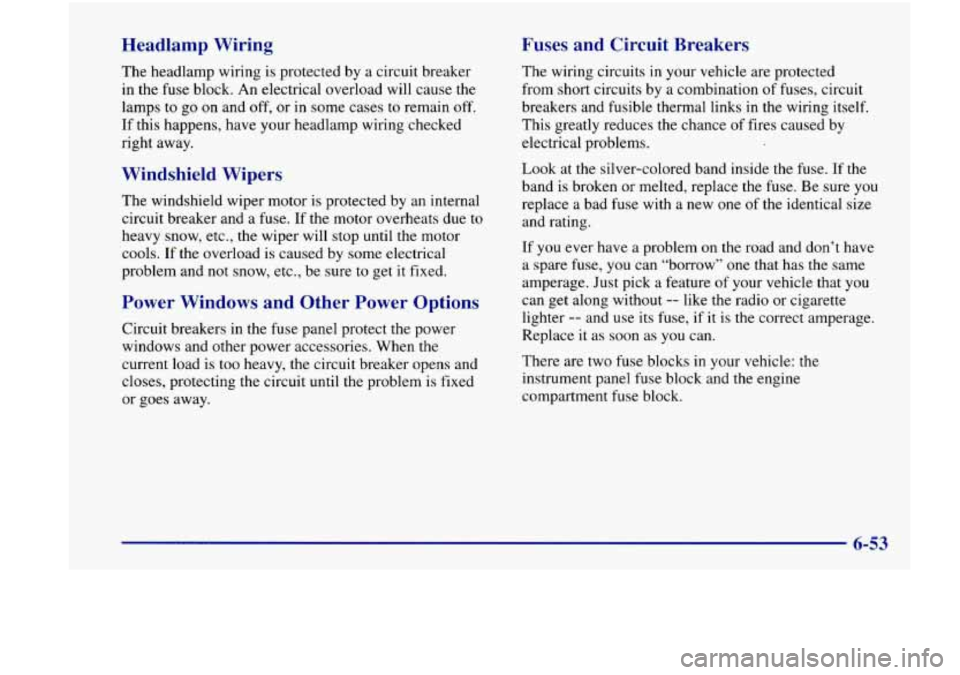
Headlamp Wiring Fuses and Circuit Breakers
The
headlamp wiring is protected by a circuit breaker
in the fuse block. An electrical overload will cause the
lamps to go on and off, or in some cases to remain off.
If this happens, have your headlamp wiring checked
right away.
Windshield Wipers
The windshield wiper motor is protected by an internal
circuit breaker and a
fuse. If the motor overheats due to
heavy snow, etc., the wiper will stop until the motor
cools.
If the overload is caused by some electrical
problem and not snow, etc., be sure to get it fixed.
Power Windows and Other Power Options
Circuit breakers in the fuse panel protect the power
windows and other power accessories. When the
current load is too heavy, the circuit breaker opens and
closes, protecting the circuit until the problem is fixed
or goes away. The
wiring circuits in your vehicle are protected
from short circuits by a combination of fuses, circuit
breakers and fusible thermal links in the wiring itself.
This greatly reduces the chance
of fires caused by
electrical problems.
Look at the silver-colored band inside the fuse. If the
band is broken
or melted, replace the fuse. Be sure you
replace a bad fuse with a new one
of the identical size
and rating.
If you ever have a problem on the road and don’t have
a spare fuse,
you can “borrow” one that has the same
amperage. Just pick a feature of your vehicle that
you
can get along without -- like the radio or cigarette
lighter
-- and use its fuse, if it is the correct amperage.
Replace it as soon as you can.
There are two fuse blocks in your vehicle: the
instrument panel fuse block and the engine
compartment fuse block.
Page 320 of 356
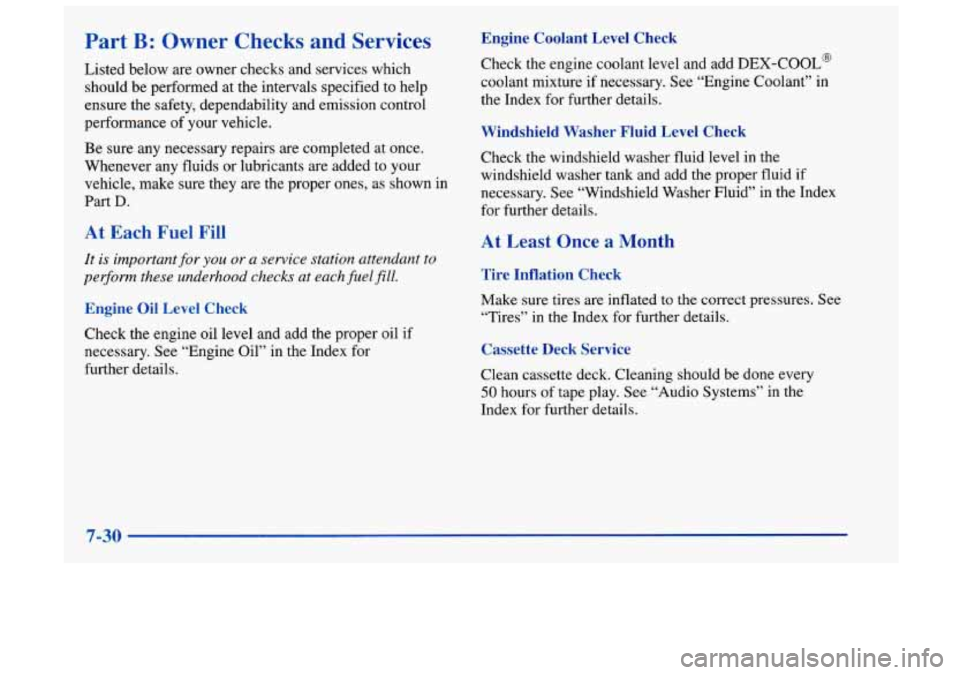
Part B: Owner Checks and Services
Listed below are owner checks and services which should be performed at the intervals specified to help
ensure the safety, dependability and emission control
performance of your vehicle.
Be sure any necessary repairs are completed at once.
Whenever any fluids
or lubricants are added to your
vehicle, make sure they are the proper ones, as shown in
Part D.
At Each Fuel Fill
It is important for you or a service station attendant to
per$orm these underhood checks at each fuel
fill.
Engine Oil Level Check
Check the engine oil level and add the proper oil if
necessary. See “Engine Oil” in the Index for
further details.
Engine Coolant Level Check
Check the engine coolant level and add DEX-COOL@
coolant mixture if necessary. See “Engine Coolant” in
the Index for further details.
Windshield Washer Fluid Level Check
Check the windshield washer fluid level in the
windshield washer tank and add the proper fluid
if
necessary. See “Windshield Washer Fluid” in the Index
for further details.
At Least Once a Month
Tire Inflation Check
Make sure tires are inflated to the correct pressures. See
“Tires”
in the Index for further details.
Cassette Deck Service
Clean cassette deck. Cleaning should be done every
50 hours of tape play. See “Audio Systems” in the
Index for further details.
7-30
Page 322 of 356

Starter Switch Check Brake-Transaxle Shift Interlock (BTSI) Check
When you are doing this check, the vehicle could
move suddenly.
If it does, you or others could be
injured. Follow the steps below.
1. Before you start, be sure you have enough room
2. Firmly apply both the parking brake (see “Parking
Brake” in the Index if necessary) and the regular brake.
NOTE: Do not use the accelerator pedal, and be
ready to turn off
the engine immediately if it starts.
around the vehicle.
3. On
automatic transaxle vehicles, try to start the
engine in each gear. The starter should work only in
PARK
(P) or NEUTRAL (N). If the starter works in
any other position, your vehicle needs service.
When you are doing this check, the vehicle could
move suddenly.
If it does, you or others could be
injured. Follow the steps below.
1. Before you start, be sure you have enough room
around the vehicle. It should be parked on
a
level surface.
2. Firmly apply the parking brake (see “Parking Brake”
in the Index if necessary).
NOTE: Be ready to apply the regular brake
immediately
if the vehicle begins to move.
3. With the engine off, turn the key to the RUN
position, but don’t start the engine. Without applying
the regular brake, try to move the shift lever out of
PARK (P) with normal effort. If
the shift lever
moves out of PARK
(P), your vehicle’s BTSI
needs service.
7-32
Page 323 of 356

Ignition Transaxle Lock Check
While parked, and with the parking brake set, try to turn
the ignition key to LOCK in each shift lever position.
With an automatic transaxle, the key should turn to
LOCK only when the shift lever is in PARK (P).
On all vehicles, the key should come out
only in LOCK.
Parking Brake and Automatic Transaxle PARK (P)
Mechanism Check
1 A CAUTLN:
When you are doing this check, your vehicle
could begin
to move. You or others could be
injured and property could be damaged. Make
sure there is room in front of your vehicle in case
it begins to roll. Be ready to apply the regular
brake at once should the vehicle begin to move.
Park on a fairly steep hill, with the vehicle facing
downhill. Keeping your foot on the regular brake, set the
parking brake.
To check the parking brake’s holding ability: With
the engine running and transaxle in NEUTRAL (N),
slowly remove foot pressure from the regular brake
pedal.
Do this until the vehicle is held by the parking
brake only.
0 To check the PARK (P) mechanism’s holding ability:
With the engine running, shift
to PARK (P). Then
release all brakes.
Underbody Flushing Service
At least every spring, use plain water to flush any
corrosive materials from the underbody. Take care to
clean thoroughly any areas where mud and other debris
can collect.
7-33
Page 340 of 356
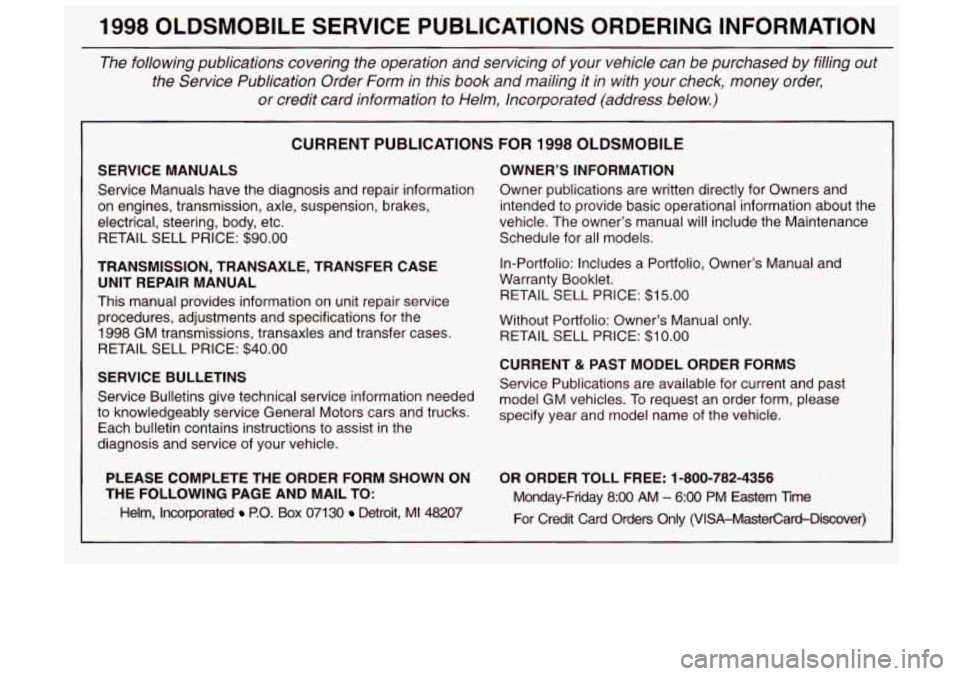
1998 OLDSMOBILE SERVICE PUBLICATIONS ORDERING INFORMATION
The following publications covering the operation and servicing of your vehicle can be purchased by filling out
the Service Publication Order Form in this book and mailing it in with your check, money order,
or credit card information to Helm, Incorporated (address below.)
CURRENT PUBLICATIONS FOR 1998 OLDSMOBILE
SERVICE MANUALS
Service Manuals have the diagnosis and repair information
on engines, transmission, axle, suspension, brakes,
electrical, steering, body, etc. RETAIL SELL PRICE: $90.00
TRANSMISSION, TRANSAXLE, TRANSFER CASE
UNIT REPAIR MANUAL
This manual provides information on unit repair service
procedures, adjustments and specifications for the
1998 GM transmissions, transaxles and transfer cases.
RETAIL SELL PRICE:
$40.00
SERVICE BULLETINS
Service Bulletins give technical service information needed
to knowledgeably service General Motors cars and trucks.
Each bulletin contains instructions to assist in the
diagnosis and service of your vehicle.
PLEASE COMPLETE THE ORDER FORM SHOWN ON
THE FOLLOWING PAGE AND MAIL TO:
Helm, Incorporated PO. Box 07130 Detroit, MI 48207
OWNER’S INFORMATION
Owner publications are written directly for Owners and
intended to provide basic operational information about the
vehicle. The owner’s manual will include the Maintenance
Schedule for all models.
In-Portfolio: Includes a Portfolio, Owner’s Manual and
Warranty Booklet. RETAIL SELL PRICE:
$1 5.00
Without Portfolio: Owner’s Manual only.
RETAIL SELL PRICE:
$1 0.00
CURRENT & PAST MODEL ORDER FORMS
Service Publications are available for current and past
model GM vehicles. To request an order form, please
specify year and model name of the vehicle.
OR ORDER TOLL FREE: 1-800-782-4356
Monday-Friday 8:OO AM - 6:OO PM Eastern Time
For Credit Card Orders Only
(VISA-MasterCard-Discover)
Page 343 of 356
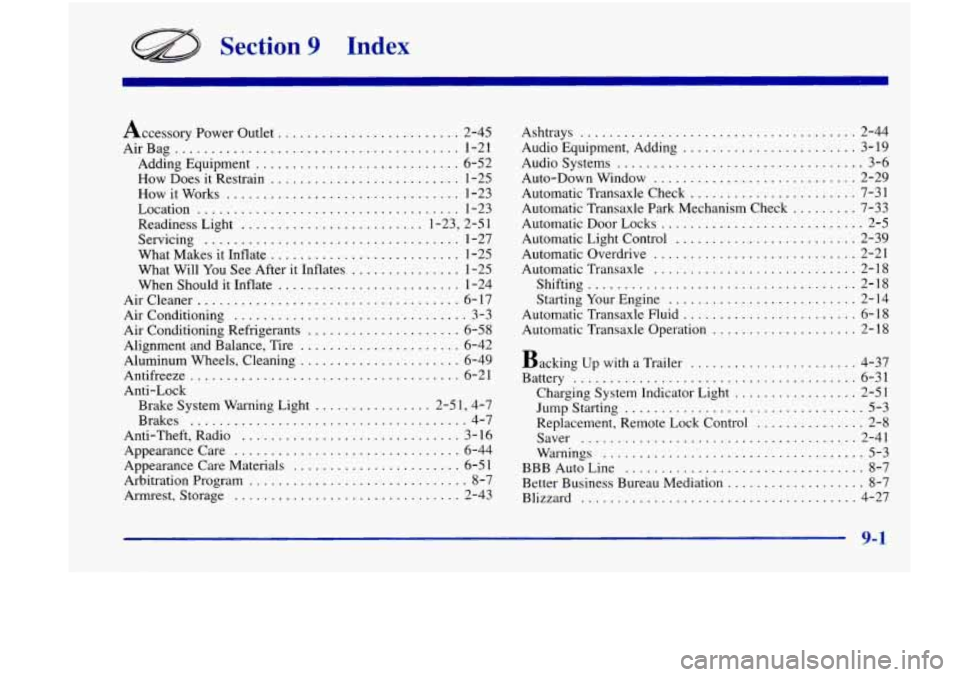
Section 9 Index
Accessory Power Outlet ......................... 2-45
AirBag
....................................... 1-21
Adding Equipment
............................ 6-52
How Does it Restrain
.......................... 1-25
How it Works
................................ 1-23
Location
.................................... 1-23
Readiness Light
......................... 1.23. 2.5 1
Servicing ................................... 1-27
What Makes it Inflate
.......................... 1-25
What Will You See After it Inflates
............... 1-25
When Should it Inflate ......................... 1-24
Aircleaner
.................................... 6-17
Air Conditioning
................................ 3-3
Air Conditioning Refrigerants
..................... 6-58
Alignment and Balance. Tire
...................... 6-42
Aluminum Wheels. Cleaning
...................... 6-49
Antifreeze
..................................... 6-2 1
Anti-Lock Brake System Warning Light
................ 2.51. 4.7
Brakes
...................................... 4-7
Anti.Theft. Radio
.............................. 3- 16
Appearancecare
............................... 6- 44
Appearance Care Materials
....................... 6-5 1
Arbitration Program .............................. 8-7
Armrest. Storage
............................... 2-43 Ashtrays
...................................... 2-44
Audio Equipment. Adding
........................ 3-19
Audio Systems
.................................. 3-6
Auto-Down Window
............................ 2-29
Automatic Transaxle Check
....................... 7-31
Automatic Transaxle Park Mechanism Check
......... 7-33
Automatic Door Locks
............................ 2-5
Automatic Light Control
......................... 2-39
Automatic Overdrive
............................ 2-21
Automatic Transaxle
............................ 2-18
Shifting
..................................... 2-18
Starting Your Engine
.......................... 2-14
Automatic Transaxle Fluid
........................ 6-18
Automatic Transaxle Operation
.................... 2-18
Backing
up with a Trailer ....................... 4-37
Battery
....................................... 6-31
Charging System Indicator Light
................. 2-51
Jumpstarting
................................. 5-3
Replacement, Remote Lock Control
............... 2-8
Saver
...................................... 2-41
Warnings
.................................... 5-3
BBB Auto Line
................................. 8-7
Better Business Bureau Mediation
................... 8-7
Blizzard
...................................... 4-27
9-1